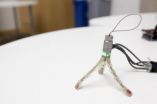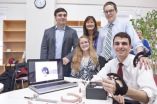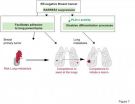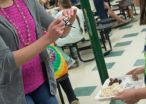(Press-News.org) Removing a malignant tumor from the head of the pancreas is a risky and demanding operation. The surgeon must carefully navigate around the stomach, the gallbladder, the bile duct, lymph nodes, and several high-pressure blood vessels.
But an inexpensive device designed by Harvard engineering students and a surgeon at Beth Israel Deaconess Medical Center offers surgeons a confident grip throughout the delicate procedure. The gentle grasper, equipped with rubberized pressure sensors, has three slender fingers that can slip through a very small incision and tease cancerous tissue away from the pancreas without squeezing too hard.
The device has the potential to reduce hemorrhaging and save lives. For now, it's offering critical lessons in engineering design to a group of undergraduate and graduate students at the Harvard School of Engineering and Applied Sciences (SEAS).
Here, a growing initiative in medical device innovation is taking shape. Engineering faculty, entrepreneurship experts, and clinicians from Harvard's affiliated hospitals are collaborating to solve complex medical problems—and creating an invaluable environment for hands-on education at SEAS.
"One of the most important things we try to teach the students is the importance of taking a rigorous, detailed approach to what can seem like a messy and ill-defined process," says Donal Holland, a visiting Ph.D. student from Trinity College, Dublin, and teaching fellow for ES 227, Medical Device Design, at SEAS. "Anyone can use trial and error to come up with something that works, but good engineers draw on their technical and analytical skills to solve problems in a deterministic way."
That approach, the cornerstone of education at SEAS, is working. The surgical grasper and three other student-designed tools earned prestigious awards from the Design of Medical Devices (DMD) Conference at the University of Minnesota this spring in recognition of the devices' technical quality, medical practicality, and potential for commercial impact.
In ES 227, where several of the winning projects originated, students are asked to help clinicians overcome a problem they face in practice. And they are challenged to design under pressure.
"A lot of clinicians, especially those who are actively involved in research, have brilliant ideas for tools and devices that can improve over current standards of care in their respective fields, but they may not necessarily have the time, personnel, facilities, or technical background to make these ideas a reality," says Joshua Gafford, a Ph.D. student at SEAS who took ES 227 last spring. "The great thing about ES 227 is that it establishes a symbiotic relationship between clinicians, who can see their ideas come to fruition, and engineering students, who have a hands-on opportunity to develop a product with observable medical implications."
"The students act as a catalyst to help make that ideation and design process more in depth, broader, better," says Conor J. Walsh, assistant professor of mechanical and biomedical engineering, who launched ES 227 at SEAS after being a teaching fellow in a similar course with Alex Slocum at MIT. "They bring a lot of passion to the class, because they're really excited to work on solving a real problem. You can't discount that in terms of how it motivates someone—to actually spend time with clinicians, putting in long hours and late nights to work on these projects—and that comes across in the final presentations."
Over the course of a semester, students in ES 227 must clarify the medical problem and practical constraints, brainstorm solutions and rigorously evaluate them, design and fabricate prototypes, iteratively test and improve them, and then present a final, working device in a publication-quality paper.
"It pushes students to really achieve their best and produce quality prototypes in a shockingly short amount of time," says Paxton Maeder-York '14, who will graduate in May with an S.B. in engineering sciences.
With a team of other students, and with mentorship from Holland, Walsh, and Dr. Catherine Wee at Spaulding Hospital for Continuing Medical Care, Maeder-York designed a soft, wearable device to help patients regain normal thumb movement—and therefore the ability to grasp objects—after a stroke. The project won the Three-In-Five contest at DMD, as did another of Gafford's devices. The students now have the opportunity to submit their findings for accelerated review by the prestigious ASME Journal of Medical Devices.
"Design courses like these are crucial to an engineer's skill set," says Maeder-York. "The theory classes provide background and history into the physics behind systems, but the most rewarding skills I have harnessed from my Harvard education have been time management, team dynamics, creative thinking, and iterative design."
After graduation, he intends to work at a start-up company in San Francisco that makes microsurgical robots.
In ES 227, students learn how to write high-quality research papers, register patents, and present at prestigious conferences—all vital skills for graduate school and careers in engineering.
"I learned a lot about the design process, how to develop a product with the end user in mind, and how to communicate design requirements to external vendors and get high-quality parts manufactured," says Gafford, who studies in Walsh's lab and was lead author of three of the winning papers at this year's DMD conference.
Approximately 30 undergraduates have also conducted research in the Harvard Biodesign Laboratory. The results are impressive. This year's crop of capstone design projects by Harvard College seniors pursuing the Bachelor of Science through SEAS includes a prosthetic hand, tools to improve cardiac catheters, new minimally invasive surgical devices, and a wearable machine that could help infants who have trouble walking.
Walsh's course is just one aspect of a growing suite of biomedical design initiatives at SEAS that also includes international research experiences and summer design fellowships. Enabled by a grant from the National Collegiate Inventors & Innovators Alliance, along with foundational and corporate support, the program is built on the premise that effective medical design requires immersion in a real clinical setting—whether that's in Boston's world-renowned hospitals or in a rural infirmary overseas.
"Building up our presence in biomedical engineering makes tremendous sense for SEAS," says Dean Cherry A. Murray, John A. and Elizabeth S. Armstrong Professor of Engineering and Applied Sciences and professor of physics. "Focusing on applications in the developing world is especially interesting because not only does it fit exactly with our mission of improving life through technology; it has the potential to be disruptive for the developed world too. Our students are excited about that, and I think they recognize it as an opportunity."
In 2012, with support from the Harvard South Asia Institute, Walsh established a program that lets students from across Harvard spend the summer in Bangalore, India, visiting private and government-run hospitals. They have the opportunity to innovate in a different cultural and economic context and then bring those ideas back to Harvard. The program has continued in 2013 and 2014 with support from the President's Innovation Fund for International Experiences, and Walsh has established a partnership with the Indian Institute of Science to jointly create new design opportunities for students during the summer.
"These initiatives are ideally suited to Harvard, where it's not unusual for a student to be interested in engineering, public health, economics, and cultural studies all at once," says Walsh, who is hoping to expand the program in the future. "Students participating in the program gain an appreciation of how they can use their skills for the benefit of others. They often continue the projects for their senior thesis, a class, an extracurricular project, or even after they graduate."
For some students, engineering design can also result in patents and start-ups.
Pratheev Sreetharan '06, Ph.D. '12, developed a pop-up fabrication technique as part of the National Science Foundation–funded RoboBee project. Building on Sreetharan's advance, Gafford and his collaborators at SEAS and the Wyss Institute for Biologically Inspired Engineering have demonstrated very small active cutting devices, powered by piezoelectric actuators like those onboard the robotic insect prototypes, that could fit inside an artery to clear a blockage. That project won the grand prize in the DMD Emerging Medical Innovation Valuation Competition.
"Despite a substantial amount of intellectual property generated thus far—in terms of the fabrication technique itself and medical applications thereof—we're really just scratching the surface in terms of the medical potential," Gafford adds.
The collaborative environment at SEAS, where multiple lab groups and courses tackle challenging projects together, complements other efforts at Harvard, such as Harvard Medical School's Catalyst educational workshops, courses on biomedical innovation at Harvard Business School, and the work of the Office of Technology Development and the Wyss Institute.
"When it comes to innovation in the classroom, SEAS is sort of the connector of all those different parts—the medical, the business, the economics—as all are important when designing and innovating," says Walsh, who is also a Wyss Institute core faculty member. "We would love to see more students from across Harvard participate in our programs."
Six student projects from SEAS have earned awards at the DMD conference in the past two years, and ES 227 was offered again this spring, producing another set of innovative devices.
"I'm delighted that they have received recognition for all their hard work," says Holland. "I think it proves how worthwhile it is to provide students with hands-on design experiences and access to great facilities."
INFORMATION:
Joshua Gafford, Samuel Kesner, Robert Wood and Conor Walsh, "Monolithic Fabrication of Millimeter-Scale Surgical Devices with Integrated Sensing," ASME Journal of Medical Devices, doi:10.1115/1.4027045.
Joshua Gafford, Ye Ding, Andrew Harris, Terrence McKenna, Panagiotis Polygerinos, Dónal Holland, Arthur J. Moser and Conor Walsh, "Shape Deposition Manufacturing of a Soft, Atraumatic, Deployable Surgical Grasper," ASME Journal of Medical Devices, doi:10.1115/1.4027048. END
Medical mechanics
Teaching medical device design in cultural context, SEAS initiative earns honors
2014-05-27
ELSE PRESS RELEASES FROM THIS DATE:
Just look, but don't touch: EMA terms of use for clinical study data are impracticable
2014-05-27
The European Medicines Agency (EMA) receives comprehensive clinical study data from drug manufacturers. These data form the basis for the decision on the approval of new drugs. To make this information available to researchers and decision-makers, EMA issued a draft policy in 2013 for the publication of clinical study data, in which extensive data transparency was planned.
Besides other interested parties, the German Institute for Quality and Efficiency in Health Care (IQWiG) was intensely involved in the subsequent consultations. The result of these consultations is ...
The future of sweet cherry in Australia
2014-05-27
AUSTRALIA -- Predicted variations in global climates have fruit producers trying to determine which crops are best suited to weathering future temperature changes. Extreme high-temperature events are expected to become more frequent, and predictive models suggest that the global mean surface air temperature will rise by as much as two degrees by the middle of the 21st century. Higher temperatures could have an impact on the duration of critical "winter chill" periods needed for successful fruit production, potentially altering growing strategies. According to the authors ...
Differences in phenolic makeup of indigenous rose species and modern cultivars
2014-05-27
LJUBLJANA, SLOVENIA – The leaves and petals of roses are valued for their medicinal and aesthetic uses around the world. A new study identified specific phenolic compounds found in the petals of indigenous rose species and compared them with the phenolic profiles of modern rose cultivars to determine differences in the makeup of roses traditionally used for medicinal purposes and those varieties cherished for aesthetic qualities. According to the results, distinct differences exist in the distribution of leaf phenolic compounds, especially between indigenous rose species ...
Researchers identify a new suppressor of breast metastasis to the lung
2014-05-27
A study published today in EMBO Molecular Medicine reveals that the loss of function of the gene RARRES3 in breast cancer cells promotes metastasis to the lung.
The research, headed by Roger Gomis, ICREA Professor at the Institute for Research in Biomedicine (IRB Barcelona), is the result of a collaboration between two IRB labs and Joan Massagué, at the Memorial Sloan Kettering Cancer Center in New York.
The scientists demonstrate that RARRES3 is suppressed in estrogen receptor-negative (ER-) breast cancer tumours, thus stimulating the later invasion of the cancer cells ...
The science of school lunch
2014-05-27
In terms of ambience, Charlotte Central's cafeteria is -- well, conjure up your own elementary school lunch experience. There's more than one reason to run to recess. But on a recent visit to observe a group of researchers from UVM's Johnson Lab, the lunch ladies were serving up something more likely to be found on a restaurant menu: risotto with mushrooms and peas. It's the result of a host of programs by schools around Vermont to offer more tempting choices -- with locally sourced ingredients when possible, including herbs and vegetables from the playground garden -- ...
New University of Colorado study illuminates how cancer-killing gene may actually work
2014-05-27
Scientists armed with a supercomputer and a vast trove of newly collected data on the body's most potent "tumor suppressor" gene have created the best map yet of how the gene works, an accomplishment that could lead to new techniques for fighting cancers, which are adept at disabling the gene in order to thrive.
Scientists from the University of Colorado Cancer Center and the University of Colorado Boulder used a new technology to tease out how the p53 gene—which is responsible for recognizing damaged DNA in cells and then marking them for death—is actually able to suppress ...
Why retailers need to pay attention to the smell of their stores
2014-05-27
This news release is available in French. Montreal, May 27, 2014 — Retail stores overflowing with merchandise can make consumers feel claustrophobic rather than ready to spend. But the recent move towards open, minimally stocked spaces can leave them feeling just as anxious.
The solution to this shopping conundrum may be smell, as new research from Concordia University shows.
In a study recently published in the American Journal of Business, researchers from the university's John Molson School of Business (JMSB) suggest that, when diffused in retail environments, ...
Imaging scientists develop a better tool for tracking MS
2014-05-27
Imaging scientists at Western University's Robarts Research Institute (London, Canada) have developed a better way to track the progression of Multiple Sclerosis (MS) from its earliest stages. Led by Ravi Menon, PhD, the researchers used what's called "Quantitative Susceptibility (QS) Magnetic Resonance Imaging (MRI)," to measure damage in specific areas of the brain which the study showed to be common to all patients. The findings are published in advance online, in Radiology.
"In MS research, there is something we call a clinical-radiological paradox. When ...
Steroids prescribed in the ICU linked to delirium
2014-05-27
New Johns Hopkins research suggests that critically ill patients receiving steroids in a hospital's intensive care unit (ICU) are significantly more likely to develop delirium. Results of their research, they say, suggest minimizing the use of steroids could reduce delirium in the ICU.
While it usually goes away after a few days, studies show delirium in the ICU has a long-term impact. It has been associated with worse functional recovery and cognitive impairments of a magnitude consistent with moderate traumatic brain injury or mild Alzheimer's disease.
Overall, up ...
HSP90 is a potential target for ameliorating skeletal muscle abnormalities in PD
2014-05-27
Heat shock protein (HSP90) has been suggested to be involved in neuronal protein misfolding and accumulation in Parkinson's disease (PD) brains leading to dopaminergic neuronal death and the eventual dopamine depletion. Therefore, HSP90 has been suggested as a therapeutic target in PD. Dr. Muhammed Al-Jarrah and co-workers from Jordan University of Science and Technology (JUST) point out exercise training significantly inhibited HSP90 overexpression in the soleus and gastrocnemius in PDe rats, which is a potential therapeutic target for ameliorating skeletal muscle abnormalities ...
LAST 30 PRESS RELEASES:
Groundbreaking discovery turns household plastic recycling into anti-cancer medication
Blocking a key inflammatory pathway improves liver structure and vascular function in cirrhosis, study finds
Continuous spread: Raccoon roundworm detected in nine European countries
HKUST Engineering researchers developed a novel photodetector to enhance the performance of on-chip light monitoring
Strategic river sensors could have forewarned of Texas Camp flood disaster
Drone sampling of whale breath reveals first evidence of potentially deadly virus in Arctic
Roman soldiers defending Hadrian’s Wall infected by parasites, study finds
Pinochet’s prisoners were tormented with music but still found solace in it, a new book reveals
Fertility remains high in rural Tanzania despite access to family planning
AI-assisted device can improve autism care access
Kinetic careers
Uncovering how parasitic plants avoid attacking themselves to improve crop resistance
Nanoparticle vaccine strategy could protect against Ebola and other deadly filoviruses
Study finds brain care score can predict risk of stroke across racial groups
Key lung immune cells can intensify allergic reactions
Do hormones explain why women experience more gut pain?
New materials conduct ions in solids as easily as in liquids
Breakthrough of the Year: Renewable energy begins to eclipse fossil fuel-based sources
LLM use is reshaping scientific enterprise by increasing output, reducing quality and more
Introducing LightGen, a chip for ultra-fast, ultra-efficient generative AI
Astronomers see fireworks from violent collisions around nearby star
ACC/AHA issue new guideline on managing congenital heart disease in adults
Cosmic crash caught on camera
Is talented youth nurtured the wrong way? New study shows: top performers develop differently than assumed
Ants: An untapped resource in the development of antibiotics?
Archaeologists use AI to create prehistoric video game
Mitochondria migrate toward the cell membrane in response to high glucose levels
Tiny viral switch offers hope against drug-resistant bacteria
Most parents aware of early peanut introduction guidelines, but confused about details
HPV vaccine can protect against severe lesions of the vulva and vagina
[Press-News.org] Medical mechanicsTeaching medical device design in cultural context, SEAS initiative earns honors





